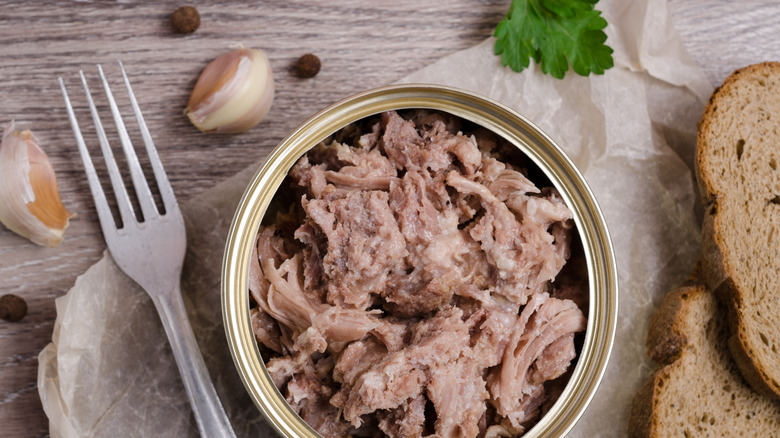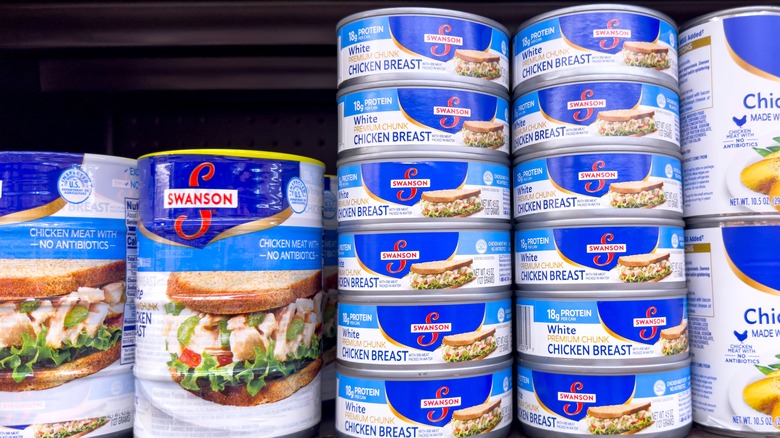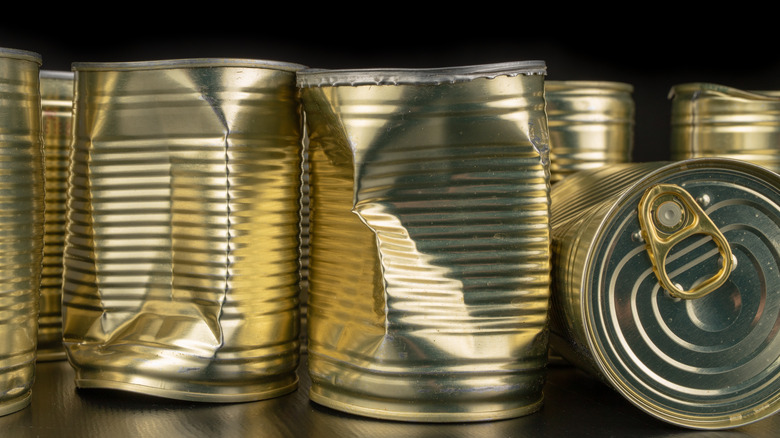Why Is Canned Chicken Pink?
Canned chicken is one of those shelf-stable items that serves as a quick and easy bite while taking up little of your pantry's coveted real estate. It's a tried and true staple most people have on hand for those nights they just don't feel like cooking, or to serve as a simple snack to eat straight from the can. At some point or another, however, you may have pulled back the lid and thought it was a can of salmon for a split second. If that not-so-appetizing shade of pink that tends to tinge canned chicken has ever given you pause, you're not alone.
Pink chicken is synonymous with raw chicken — and we've been conditioned from a young age to avoid it like the plague because, let's face it, a bad bout of food poisoning can feel just like a plague. Fortunately, the same rules do not apply to chicken in a can. According to the USDA, not only is canned chicken with a pink hue safe to consume, but thanks to science, it's perfectly normal.
Upon opening the can, you will see some pink, which is caused by chemical changes during the cooking process. A protein in the chicken's muscle tissue, myoglobin, is responsible for the color. Traces of hemoglobin in the tissue and even just the age of the bird can make the meat look pink. This color will slowly fade over 10 to 15 minutes as the chicken is exposed to oxygen.
How canned chicken is made
If the pink still leaves you feeling a bit uneasy, knowing how canned chicken is made may help assuage any fears. Few may know that, often, the cooking occurs after the meat is packed and sealed in the airtight ribbed can. The cans are then heated thoroughly to cook all of the meat, ensuring there is zero chance that any chicken is raw. The USDA (FSIS) requires all chicken products to be cooked to 165 degrees Fahrenheit to kill off any harmful bacteria. The airtight can acts as a barrier to oxygen, which bacteria need to grow, so the contents are contained and safe until it is opened.
Certain factors during cooking and canning may also be behind the pink. Preservatives used during the packaging process may be at play. Sodium phosphate is often added to canned chicken to help with freshness and texture and can contribute to the color of the cooked meat. Per the USDA, what the chickens ate prior to canning is also a cause. Nitrates or nitrites that are sometimes present in feed and water supply can lend a pinkish tinge. Other contributors to the pink color during the cooking and processing include equipment used, other non-meat ingredients, the cooking method, and irradiation of the meat.
How to tell if a can of chicken has turned
Knowing the possible causes and science behind the pink color of canned chicken can help us disregard that gut impulse that tells us to question its safety. However, there are other indicators of spoilage that should not be ignored.
Canned chicken will have a shelf-life of two to five years when stored properly in a cool, dry place, per the USDA. There are some signs you want to look for that indicate possible dangerous bacteria, particularly botulism. Any cans that are leaking or have dents, rust, swelling, or bulging are best tossed to be safe. If you open it up, and it smells off, sour, or just plain bad, the meat has most likely spoiled. If the chicken looks discolored or has spots of either gray or green or black and brown, it is also best to toss it. Any foaminess or cloudiness, or if the can spits out liquid when you open it, are also strong signs that the can has gone bad. When in doubt, throw it out.



